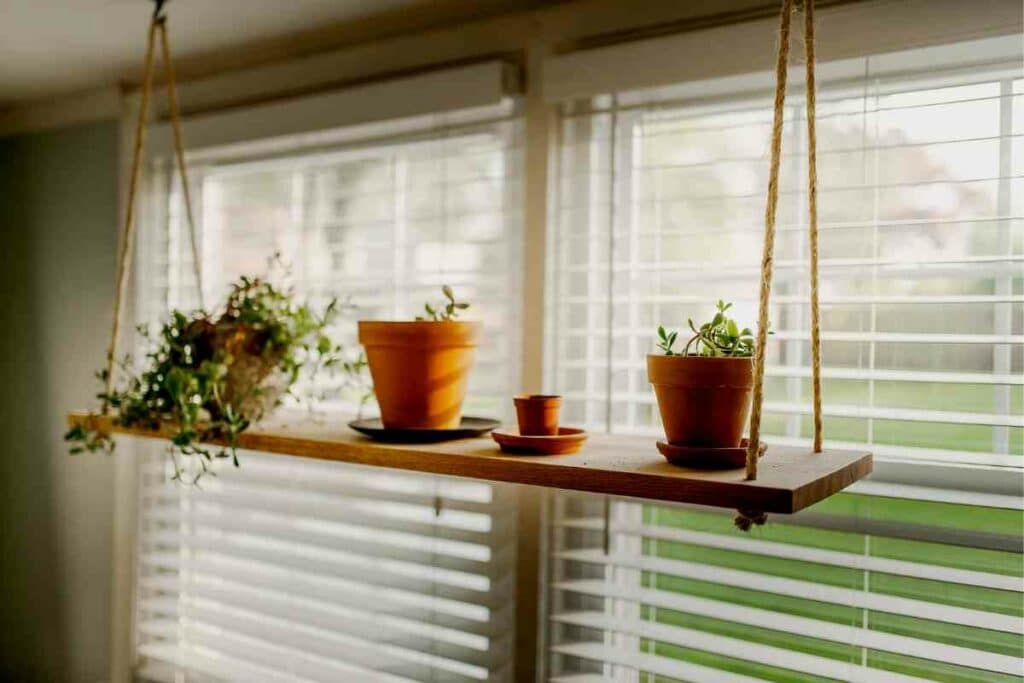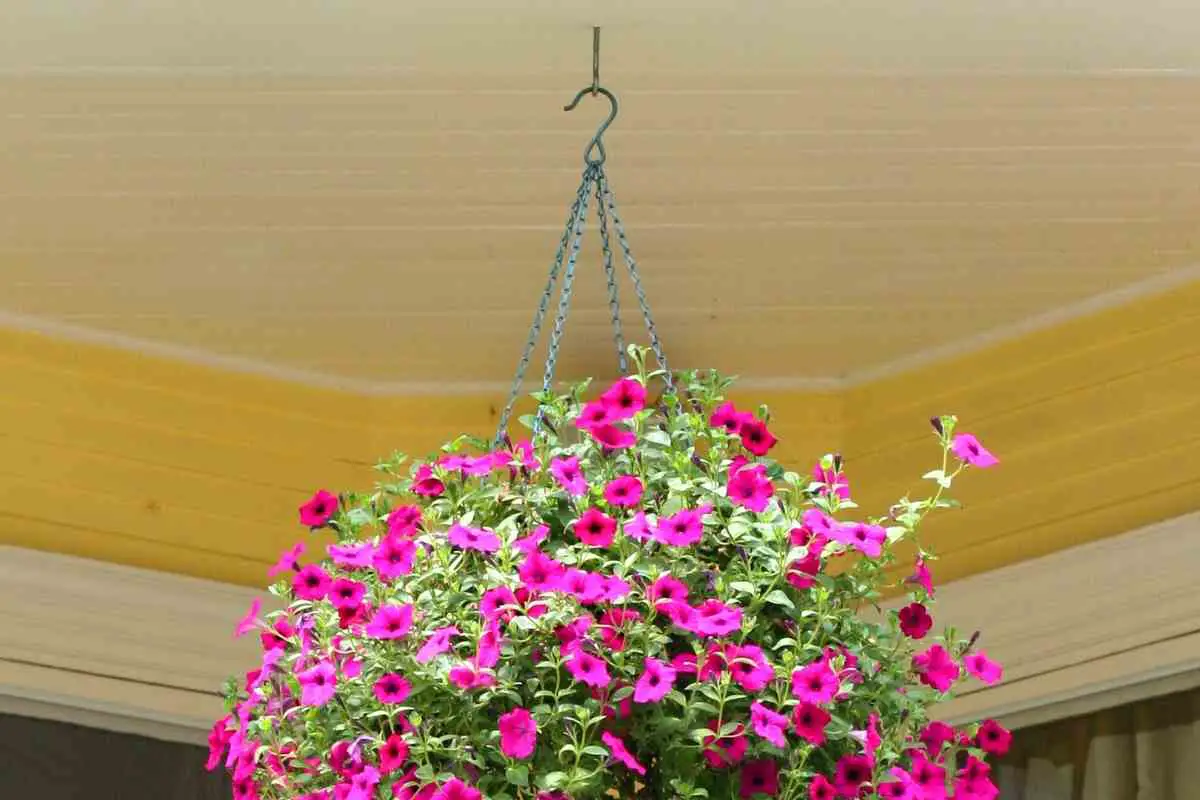If you are a houseplant lover, you may be finding that the level surfaces in your home have become crowded with foliage of all shapes and sizes.
If you need more space for growing or keeping plants, the only way is up!
Hanging plants from your ceiling is not only space-saving but stylish and keep your precious plants well out of the reach of children or pets.
To do this right, you’ll need the right hardware.
What to Expect? In this article, we will explain the essentials of selecting suitable ceiling hooks for hanging plants and how to securely hang plants from your ceiling.
Why is the right ceiling hook important?
If you were thinking of using Gorilla glue or duct tape and hoping for the best, hit the pause button and think it through.

The mechanism you use to suspend your plant from your ceiling needs to be extremely secure and capable of bearing the weight of the plant and its pot, or you’ll damage your ceiling AND your plant when it hits the floor.
The hook also needs to penetrate your ceiling material and have a good hold, which is not always straightforward.
But with the right tools for the job, you can quickly and safely secure your hanging plants.
Here are some suitable ceiling hooks for hanging plants
These are the basic options for ceiling hooks for your hanging baskets and containers.
The size and caliber of the hook you use depend on the weight of your installations.
Choose from these four options.
Option 1: The hook screw
Hook screws or screw hooks are simple, reliable, and quick to install.
These screws are the most common solution for handing plants from your ceiling, with some screw hooks being able to carry a 50-pound weight.
They comprise a metal hook with a threaded shank you can screw into stud or joists of your ceiling, after creating a guide hole with a drill.
Here are some examples of hook screws that are available to buy online
Option 2: The toggle-bolt
A toggle bolt or butterfly anchor is a solution for installing your ceiling hook in drywall or a suspended ceiling.
With these weaker ceilings, the weight that can be held per hook is lower, around 15 to 25 pounds.
Toggle bolts have a hook, a bolt, and spring-loaded wings that are passed through a small drilled hole and opened up on the inside of the ceiling.
The hook can then bear its load by distributing the weight with a wide grip on the inside of the ceiling.
Here are some examples of toggle bolts that are available to buy online
Option 3: The S-hook
If you have something you can hang your hook off, the S-hook can provide a drill and hassle-free solution.
One end of the S hooks slips over accessible beams or pipes, and you can use the other end as a hook for your planter.
Here are some examples of S-hooks that are available to buy online
Option 4: Drop ceiling hooks
Some great modern designs provide a reliable no-drill solution for drop ceilings.
These hooks clip onto the frame of the suspended ceiling rather than penetrating the ceiling tiles.
Here are some examples of drop ceiling hooks that are available to buy online
Option 5: Heavy-duty ceiling hooks
Heavy-duty ceiling hooks have a circular metal plate that the hook protrudes from.
This type of hook accommodates a maximum holding weight of 50 pounds.
You can secure the metal plate to a ceiling joist via three or more holes in the plate.
Here are some examples of heavy-duty ceiling hooks that are available to buy online
How to hang plants from your ceiling
It is easy to use hanging planters, hanging plants, and the right ceiling hook to create a beautiful display.
Let’s run through the steps for hanging plants from your ceiling.
Here’s what you’ll need:
- A plant hanger (if you are a macrame fanatic, this is the time to put your skills to good use)
- A ceiling hook that is suitable for the job
- A stud locator to help you find the ceiling stud and joist
- A power drill
- Pencil
- A step ladder
Step 1: Choose the planter(s) for the plant(s) you want to hang
There are so many styles of hanging planters to choose from including rope, geometric, metal, and plastic hanging planter pots.
Make sure that the planter includes a draining solution or choose a self-watering planter.
Nowadays, there is also a greater range of shapes including rectangular or novelty shapes that may require multiple ceiling hooks.
It will all depend on the plant you select for hanging.
Step 2: Select a suitable location on your ceiling
Just like hanging a picture on a wall, you need a spot where the ceiling has adequate strength and accessibility for watering and plant growth.
You also need a ceiling material that is not too hard, too soft, or crumbling. Of course, proximity to lighting, wires, and pipes is a no-no.
Step 3: Choose a suitable ceiling hook
Identify the right ceiling hook for the job using our guide above.
The size and weight of your planter plus plant and your ceiling type will determine which type of hook is best for your situation.
Don’t take the shortcut of using plastic hooks or self-adhesive hooks for hanging plants from your ceiling.
Step 4: Install your ceiling hook
Gather your tools and hardware, including a stepladder, to get your selected ceiling hook screwed in.
Mark the area where you intend to place the ceiling hook with a pencil.
The strongest place to screw in your ceiling hook is directly into a ceiling joist or stud. Use the studs finder to identify the nails or screws in the joist. Then you can install the ceiling hook confidently.
Drill pilot holes for the shank of your hook or its screw holes. A pilot hole should always be much smaller than the diameter of the screw threads.
It is just to get the point of the hook or screw into the ceiling.
Push the screw or shank of your hook into the drilled hole and manually screw it in until its base is flush with your ceiling.
This quick video outlines the steps beautifully:
Alternative 1: Installing a toggle bolt in drywall ceilings
If you have a drywall ceiling, without a solid beam or stud to secure your ceiling hook, you can use a toggle bolt to provide the hold you need:
- Look for a hollow spot in your ceiling and mark it with your pencil.
- Drill a ½-inch hole, roughly the size of the closed toggle-bolt
- Take your toggle bolt in hand and close its wings with your fingers while pushing it through the hole.
- Once the wings are fully through the hole and opened in the void, tighten the bolt of the toggle for a secure fit.
Watch Kristine hang her plants with a toggle bolt:
Alternative 2: Installing an S-hook on an exposed pipe or beams
If you have an accessible pipe or beam, attaching a ceiling hook will be a drill-free operation!
Simply use an S-hook to hang your plants.
It simply slips over the pipe, leaving a curved hook free to hang your plants.
You can even make your S hooks for hanging plants using this neat tutorial:
Step 5: You’re ready to hang your plant!
With a solid hook in place, you can move your plant into its new high-rise home.
Putting in the effort to install your hook correctly means you can be confident gravity won’t get its way with it.
Here’s some inspiration for your hanging plant collection
Check out these beautiful indoor hanging house plants that are easy growers:
Rounding up
There is no need for trepidation when installing your indoor hanging garden.
With the right hardware and installation techniques, you could confidently hang a small tree from your ceiling!
Always check the weight capacity of the hook you choose to hang your plants so you can be confident that they are fully supported.
The only worry now is remembering to keep your new addition well-watered!
